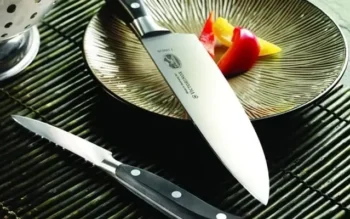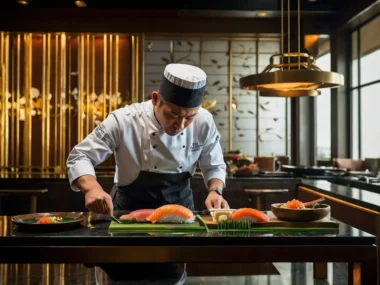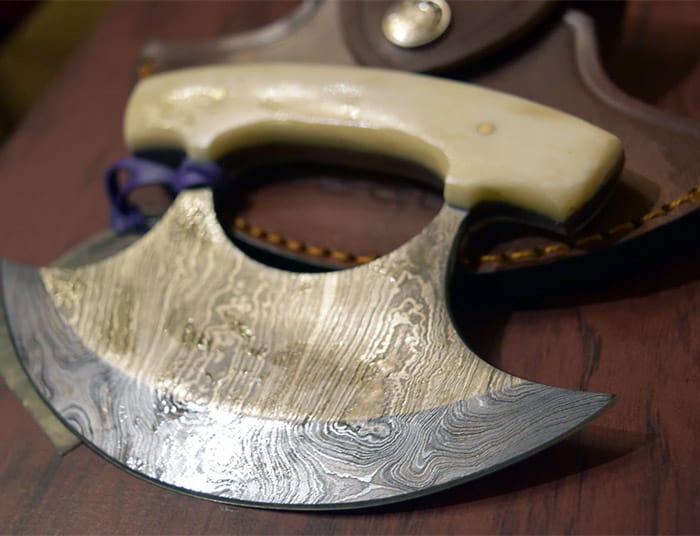
Chef vs Paring Knife: Which Blade is Best for Fine Cutting?
When you need to make precise cuts in the kitchen, choosing between a paring knife and a chef knife can make all the difference. Both

Our Kitchen Knife reviews include top Japanese and German chef knives and promising new brands. Popular kitchen knife styles include Nakiri, Kiritsuke, Santoku, Bunka, Cleavers, Paring, Ulu, and Mezzaluna Knives.

Japanese knives exemplify meticulous craftsmanship and are inspired by the Samurai sword. The high carbon steel delivers sharp, durable edges for precise cutting. These blades last longer than standard kitchen knives.

Keeping your knife in good working order is essential. A sharp blade is safer to use and lets you get the job done quickly. See our reviews on knife sharpeners, knife storage, and other accessories.

The Knife Buzz team are knife enthusiasts who love to research the details and to provide helpful information.
We offer well-researched buyers guides and reviews on knife styles and brands.
Our easy to read summaries will help you to make smart buying decisions that save time and money.
This guide covers a wide variety of knives available for the kitchen and outdoors to help you choose the right knife,. The guide also provides advice on knife accessories, knife sharpeners, knife storage, knife maintenance, and knife safety tips.
A good knife is designed for a specific task and needs to have:
Types of Knives Ultimate Buying Guide
Knife Buzz provides expert knowledge about knives and knife accessories including ratings and data about how they measure up in various categories of performance. We explain what sets a product apart from its competitors, and suggest other comparable products based on price or use.
We also look at how the knives have been designed, and what type of person they are targeted to – so you can make your decision based on what is right for you.
For tips on picking the right chef knife for your kitchen.
Knowing the parts of a knife is essential for maintaining the knives you have and choosing a new knife to suit your needs.
Most knives can be divided into two sections, the blade, and the handle. Each section can be further subdivided into parts which can vary by knife. These parts are easily recognizable once you learn their names, locations, and functions.
Knife Anatomy Explained Buyers Guide
How do you hold a knife? The answer could depend on the type of knife you have. In general, you should have a relaxed but firm grip while your other hand should stay clear of the blade to avoid accidents.
There are three different hand positions when using your knife to slice, chop or mince:
When using a chef knife:
Knife handling tips
Keeping your blades clean will help them perform better and last longer. And these special requirements will keep your knife performing at its best.
Different types of blades have different care needs:
Knife maintenance
Both Ceramic and steel knives have a place in the kitchen. Ceramics are ideal for slicing meat, fruit and vegetables while steel is best for demanding cutting tasks.
Ceramic knives have a toughness rating of 8.5, while the average steel blade has a range of 4 to 6, depending on the steel type.
Best Ceramic Knives Knives Buyers Guide
Nakiri knives cut down your food prep time. With their heavyweight construction, these blades can easily chop down on the thickest leafy greens with ease.
Nakiris Are Great for Chopping Vegetables – Nakiri blades are designed to chop greens and vegetables. Most blades also have built-in bevels to reduce unnecessary friction while chopping.
Nakiri Knives Help Conserve Energy – Nakiri blades are straight-edged so you cut down to the cutting board without excess force.
Soft Chopping Tasks – Nakiri knives are great for chopping fruit, vegetables, and food with a soft or fleshy exterior.
Thin Slicing Tasks – Nakiris are perfect for cutting thin, even slices and are ideal for cooking a vegetable stir-fry.
Nakiri Knife: Is it the Best Vegetable Chopper?

When you need to make precise cuts in the kitchen, choosing between a paring knife and a chef knife can make all the difference. Both

If you’re thinking about upgrading your kitchen tools, you might be asking yourself if a Nakiri Knife is better than a chef knife. A Nakiri

Ceramic knives have found their way into lots of kitchens lately. Made from tough, lightweight zirconia, they’re famous for their sharpness and how long they

The Ulu knife has a curved blade that is handy for chopping, slicing, and dicing all sorts of foods. Ulu knives can tackle everything from

Deciding between a cleaver and a chef knife can really shake up your kitchen routine. Each knife has its own personality. If you want easy,

A good set of kitchen knives can make cooking easier and safer. Whether you are chopping vegetables, slicing meat, or cutting bread, sharp and reliable

Knife Buzz offers independent product reviews on a wide range of knives used in the kitchen, home, outdoors and at work.
The Knife Buzz Team are passionate about reviewing knives and we cater to a targeted audience that needs independent advice before purchasing.
KnifeBuzz.com may earn affiliate commissions on some pages of this website. Knife Buzz is a participant in the Amazon Services LLC Associates Program, an affiliate advertising program designed to provide a means for sites to earn advertising fees by advertising and linking to Amazon.com. Amazon and the Amazon logo are trademarks of Amazon.com, Inc, or its affiliates. When you click links to various merchants on this site and make a purchase, this can result in this site earning a commission. Other affiliate programs and affiliations include, but are not limited to, Google AdSense.